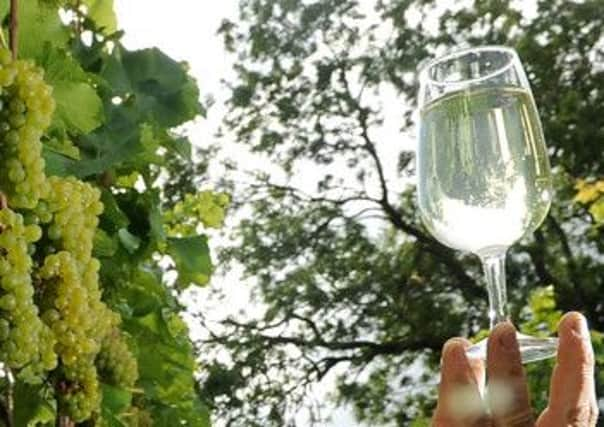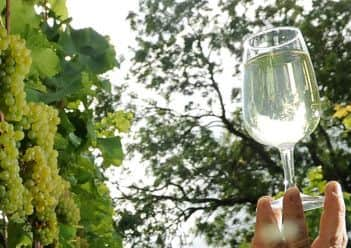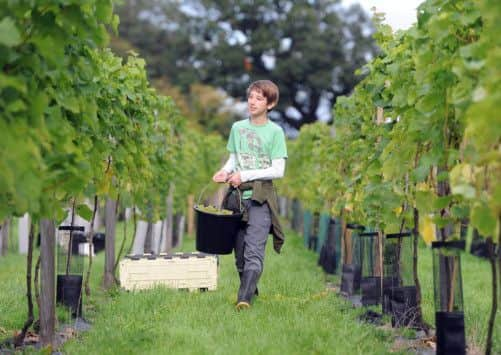Winery’s grape expectations fed by vintage year


But the legacy of months of fine weather is just beginning to bear fruit as a Yorkshire vineyard reaps what promises to be its best harvest ever.
Chris and Gillian Spakouskas, who run Yorkshire Heart Vineyard, at Nun Monkton, in the Vale of York, are hoping to double the wine they make from this year’s harvest to 10,000 bottles.
Advertisement
Hide AdAdvertisement
Hide AdIn recent day friends, family and volunteers – picking grapes in Yorkshire still has novelty value – have been working the rows of vines, heavily hung with fruit.


It’s hard to imagine that just six years ago the field was under a crop of oil seed rape.
It’s the time of year when all the hard effort start to pay – a moment keenly anticipated, although with a shade of nerves.
Chris said: “It is what we spend the whole year building up to.
Advertisement
Hide AdAdvertisement
Hide Ad“We do a lot of work on the vines virtually every month of the year and this is what it is all for: we are not that keen on growing on vines – we want to pick the grapes.


“You don’t need massive tropical heat, but you do need the brightness of the sunshine.
“Ideally you need light days; warm days and cool nights mean grapes ripen really well.
“The weather has been absolutely fine since April and May, with a bit of rain, plenty of sunshine and a breeze to keep fungal diseases away.
Advertisement
Hide AdAdvertisement
Hide Ad“It has been a good summer – I won’t pretend it hasn’t. We’ve had to put a lot of extra feed on because there’s that much fruit on the vines.
“This should be the best we’ve had, but we’ve only had four harvests.
“We made 5,000 bottles last year and I would be disappointed if we didn’t make 10,000 this year.”
Traditionally seen as struggling with a cold climate, improved rootstocks with resistance to rot, which can be trained more easily and are earlier flowering mean grapes can grow successfully in Yorkshire, as they did under the Roman and later Cistercian and Benedictine monks.
Advertisement
Hide AdAdvertisement
Hide AdThis year marks a significant step for the vineyard as it will make two single varietal wines for the first time – a Pinot Noir and a dessert wine from an aromatic grape variety, Siegerrebe, which is bred in Germany.
After harvesting their main wine grape Rondo, Solaris and Siegerrebe, the other grapes wait another two weeks before they are picked, hopefully with just the right balance of acid and sugar.
Chris said: “The sugar rises quite slowly until the last minute when it can go crazy and the sugar levels can zoom up and the acidity drops, which happens naturally.
“What we want to do is time it so there is still some acidity; you need the acid to preserve it and give it flavour.
Advertisement
Hide AdAdvertisement
Hide Ad“If you picked really high sugared fruit you would be making alcoholic fruit juice, which wouldn’t be very nice.”
Harvesting has also started in the southern counties of England, where some varieties more associated with Mediterranean climates like Cabernet Sauvignon and Merlot can be grown in polytunnels.
Julia Trustam Eve, of English Wine Producers, said: “It has started with some of the earlier ripening varieties but we are a week or two behind because everything got off to a slow start.”
They are now officially 432 vineyards in the UK and acreage in plantings has nearly doubled in under a decade. She said: “On the whole we have experienced a steady growth which is lovely over the last nine years and we expect to see the fruits of that over the next few years.”
Advertisement
Hide AdAdvertisement
Hide Ad“There are two or three growers in Scotland, but Yorkshire is really where the most northerly vineyard are,” added Julia.
“It certainly opens people’s eyes when they see how far north they go.
“It comes back to site selection. Our wine growers also select vines that can cope with a cool marginal climate.
“They would be crazy to be planting too much Shiraz and Merlot.”